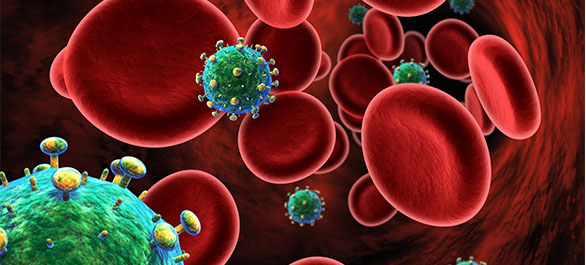
การจัดการภาวะแทรกซ้อนยาต้านรีโทรไวรัส ตอน 24
- โดย ภก.วิชญ์ภัทร ธรานนท์
- 21 มกราคม 2562
- Tweet

นิ่วในระบบทางเดินปัสสาวะ และผลึกในปัสสาวะ
ยากลุ่มโปรติเอส อินฮิบิเตอร์ (PIs) มีผลทำให้เกิดนิ่วในระบบทางเดินปัสสาวะได้ โดยยาที่เป็นสาเหตุได้บ่อย คือ อินดินาเวียร์ (indinavir) (ร้อยละ 4.7-34.4) และมีรายงานว่าเป็นจากยาอะทาซานาเวียร์ (atazanavir) และดารุนาเวียร์ (darunavir) ได้บ้างแต่ไม่บ่อย สาเหตุของการเกิดนิ่วและผลึกในปัสสาวะในผู้ที่ได้ยาอินดินาเวียร์ คือ การมีปัสสาวะเป็นด่างและการขาดน้ำ ซึ่งทำให้เกิดการตกตะกอนของผลึกของยาอินดินาเวียร์ที่ไม่ละลายน้ำ ผู้ติดเชื้อที่ได้รับยานี้จะมาด้วยอาการปวดเอว ปวดท้อง และปัสสาวะขัดหรือปัสสาวะบ่อย ให้สงสัยภาวะนี้ถ้าพบเม็ดเลือดขาวในปัสสาวะ แต่ไม่มีการติดเชื้อของระบบทางเดินปัสสาวะ และพบเม็ดเลือดแดงหรือผลึกในปัสสาวะ บางรายอาจจะมีค่าครีเอตินิน (creatinine) สูงขึ้น หรืออาจจะมีภาวะไตวายเฉียบพลันแต่พบได้น้อย ปัจจัยเสี่ยง ได้แก่ มีประวัตินิ่วในระบบทางเดินปัสสาวะมาก่อน ดื่มน้ำน้อย มีระดับยาอินดินาเวียร์สูง รับประทานยามาเป็นเวลานานและอยู่ในที่ที่มีอากาศร้อน
นิ่วในถุงน้ำดี
โดยยาอะทาซานาเวียร์ (atazanavir) เป็นยากลุ่มโปรติเอส อินฮิบิเตอร์ (PIs) ทำให้เกิดนิ่วในถุงน้ำดี ผู้ป่วยติดเชื้อจะมาด้วยอาการปวดท้อง โดยมัธยฐานของเวลาที่เกิดอาการตั้งแต่ได้รับยา คือ 42 เดือน ผู้ป่วยที่มีประวัตินิ่วที่ไตจะมีความเสี่ยงต่อการมีนิ่วในถุงน้ำดีได้ด้วย และมีรายงานการเกิดภาวะแทรกซ้อน เช่น ถุงน้ำดีอักเสบ (cholecystitis) ตับอ่อนอักเสบ นิ่วในท่อน้ำดีอักเสบ
สำหรับยากลุ่ม NRTIs และ NNRTIs มักไม่ทำให้เกิดนิ่วในระบบทางเดินปัสสาวะและผลึกในปัสสาวะ
การป้องกัน
หลีกเลี่ยงการใช้ยาอินดินาเวียร์ และควรดื่มน้ำอย่างน้อย 1.5 – 2 ลิตร หรือมากกว่า โดยเฉพาะถ้าอากาศร้อนหรือมีการเสียน้ำ และติดตามการทำงานของไต ทั้งนี้หากผู้ป่วยได้รับยาในกลุ่มโปรติเอส อินฮิบิเตอร์ (PIs) แล้วเกิดอาการไม่พึงประสงค์ดังกล่าวข้างต้น ควรรีบไปพบแพทย์โดยทันที
การรักษา
การให้สารน้ำ และให้ยาแก้ปวด ควรเปลี่ยนยาอินดินาเวียร์ หรืออะทาซานาเวียร์เป็น ยาชนิดอื่น ถ้าพิจารณาแล้วว่านิ่วและผลึกที่พบนี้เป็นจากยา 2 ชนิดนี้
จากบทความ 23 ตอนที่ผ่านมาทำให้ท่านผู้ติดตามทราบว่า ปัจจุบัน การรักษาโรคติดเชื้อเอชไอวีด้วยยาต้านรีโรไวรัสได้เปลี่ยนแปลงอย่างยิ่งใหญ่ ความก้าวหน้าของยาต้านรีโทรไวรัส สามารถทำให้ผู้ป่วยเด็กติดเชื้อเอชไอวีมีชีวิตอยู่รอดเป็นผู้ใหญ่ได้ด้วยสูตรยาที่ประกอบด้วยยาต้านรีโทรไวรัสที่มีประสิทธิภาพสูงอย่างน้อย 3 ชนิดร่วมกัน (HAART: Highly Active Antiretroviral Therapy) แต่อย่างไรก็ตาม ยาต้านรีโทรไวรัสล้วนแต่สัมพันธ์กับอาการไม่พึงประสงค์ที่อาจเกิดขึ้นได้ เช่น ภาวะหัวใจและหลอดเลือด ภาวะเมตาบอลิก ภาวะไขมันในเลือดสูง ภาวะดื้ออินซูลินและเบาหวาน ภาวะพิษต่อไต ภาวะพิษต่อกระดูก เป็นต้น
ทีมผู้ให้การดูแลผู้ป่วยติดเชื้อเอชไอวีควรทราบและนึกถึงอาการไม่พึงประสงค์จากยาต้านรีโทรไวรัส ให้การป้องกันและรักษาที่ถูกต้อง ซึ่งจะช่วยลดอัตราการเกิดทุพลภาพและการเสียชีวิตจากผลไม่พึงประสงค์ดังกล่าวได้ และสนับสนุนให้ผู้ป่วยติดเชื้อเอชไอวีมีอายุที่ยืนยาวขึ้น
สำหรับบทความนี้เป็นบทความสุดท้าย เรื่องการจัดการภาวะแทรกซ้อนจากยาต้าน รีโทรไวรัส สำหรับบทความต่อไป จะนำเสนอเรื่อง การเปลี่ยนชนิดยาต้านรีโทรไวรัสเพื่อจัดการอาการไม่พึงประสงค์จากยา ซึ่งตั้งใจนำเสนอแง่มุมการปรับเปลี่ยนสูตรยาต้านรีโทรไวรัสให้กับแพทย์ผู้ทำการรักษาผู้ป่วยติดเชื้อเอชไอวี สำหรับผู้ป่วยก็สามารถติดตามบทความต่อไปได้เช่นกันเพื่อให้ทราบเหตุผลของการเปลี่ยนแปลงสูตรยาต้านรีโทรไวรัส กรณีเกิดอาการไม่พึงประสงค์ขึ้น
บรรณานุกรม:
- Department of disease control, Thailand National Guidelines on HIV/AIDS Treatment and Prevention 2017. availavle from http://www.thaiaidssociety.org/images/PDF/ hiv_thai_guideline _2560.pdf.
- Cohen DE, Mayer KH. Primary care issues for HIV-infected patients. Infect Dis Clin N Am 21 (2007): 49–70.
- วีรวัฒน์ มโนสุทธิ. Current management of complication of antiretroviral therapy. ใน: ชาญกิจ พุฒิเลอพงศ์, ณัฏฐดา อารีเปี่ยม, แสง อุษยาพร, บรรณาธิการ. Pharmacotherapy in infectious disease VII. กรุงเทพมหานคร. สำนักพิมพ์แห่งจุฬาลงกรณ์มหาวิทยาลัย. 2558, หน้า 198-201.
- Group TISS. Initiation of Antiretroviral Therapy in Early Asymptomatic HIV Infection. New England Journal of Medicine. 2015;373(9):795-807.
- Group TTAS. A Trial of Early Antiretrovirals and Isoniazid Preventive Therapy in Africa. New England Journal of Medicine. 2015;373(9):808-22.
- Ayoko R. Bossou SC, Karen K. O’Brien, Catherine A. Opere, Christopher J. Destache. Preventive HIV Vaccines: Progress and Challenges. US Pharmacist. 2015 OCTOBER 16, 2015:46-50.
- รัชนู เจริญพักตร์ และ ชาญกิจ พุฒิเลอพงศ์. Current update on HIV/AIDs treatment guideline in 2017. ใน: ชาญกิจ พุฒิเลอพงศ์, โชติรัตน์ นครานุรักษ์, และ แสง อุษยาพร, บรรณาธิการ. Pharmacotherapy in infectious disease IX. กรุงเทพมหานคร. สำนักพิมพ์แห่งจุฬาลงกรณ์มหาวิทยาลัย. 2560, หน้า 342-364.
- Wada N JL, Cohen M, French A, Phair J, Munoz A. Cause-specific life expectancies after 35 years of age for human immunodeficiency syndrome-infected and human immunodeficiency syndrome-negative individuals followed simultaneously in long-term cohort studies, 1984-2008. Am J Epidermol. 2013; 177: 116-125.
- Department of Health and Human Services. Guidelines for the Use of Antiretroviral Agents in Adults and Adolescents Living with HIV Available from: https://aidsinfo.nih.gov/guidelines.
- O'Brien ME, Clark RA, Besch CL, Myers L, Kissinger P. Patterns and correlates of discontinuation of the initial HAART regimen in an urban outpatient cohort. Journal of acquired immune deficiency syndromes (1999). 2003;34(4):407-14.
- Kiertiburanakul S, Luengroongroj P, Sungkanuparph S. Clinical characteristics of HIV-infected patients who survive after the diagnosis of HIV infection for more than 10 years in a resource-limited setting. Journal of the International Association of Physicians in AIDS Care (Chicago, Ill : 2002). 2012;11(6):361-5.
- Wiboonchutikul S, Sungkanuparph S, Kiertiburanakul S, Chailurkit LO, Charoenyingwattana A, Wangsomboonsiri W, et al. Vitamin D insufficiency and deficiency among HIV-1-infected patients in a tropical setting. Journal of the International Association of Physicians in AIDS Care (Chicago, Ill : 2002). 2012;11(5):305-10.
- Wilde JT, Lee CA, Collins P, Giangrande PL, Winter M, Shiach CR. Increased bleeding associated with protease inhibitor therapy in HIV-positive patients with bleeding disorders. British journal of haematology. 1999;107(3):556-9.
- European AIDS Clinical Society. EACS Guidelines version 8.1-October 2016. Available from http://www.eacsociety.org/files/guidelines_8.1-english.pdf.
- ศศิโสภิณ เกียรติบูรณกุล. การดูแลรักษาผู้ติดเชื้อเอชไอวีแบบผู้ป่วยนอก.กรุงเทพฯ : ภาควิชาอายุรศาสตร์ คณะแพทยศาตร์โรงพยาบาลรามาธิบดี มหาวิทยาลัยมหิดล, 2557
- Morse CG, Mican JM, Jones EC, Joe GO, Rick ME, Formentini E, et al. The incidence and natural history of osteonecrosis in HIV-infected adults. Clinical infectious diseases : an official publication of the Infectious Diseases Society of America. 2007;44(5):739-48.
- Woodward CL, Hall AM, Williams IG, Madge S, Copas A, Nair D, et al. Tenofovir-associated renal and bone toxicity. HIV medicine. 2009;10(8):482-7.
- Wang H, Lu X, Yang X, Xu N. The efficacy and safety of tenofovir alafenamide versus tenofovir disoproxil fumarate in antiretroviral regimens for HIV-1 therapy: Meta-analysis. Medicine. 2016;95(41):e5146.
- Redig AJ, Berliner N. Pathogenesis and clinical implications of HIV-related anemia in 2013. Hematology American Society of Hematology Education Program. 2013;2013:377-81.
- Assefa M, Abegaz WE, Shewamare A, Medhin G, Belay M. Prevalence and correlates of anemia among HIV infected patients on highly active anti-retroviral therapy at Zewditu Memorial Hospital, Ethiopia. BMC Hematology. 2015;15:6.
- de Gaetano Donati K, Cauda R, Iacoviello L. HIV Infection, Antiretroviral Therapy and Cardiovascular Risk. Mediterranean Journal of Hematology and Infectious Diseases. 2010;2(3):e2010034.
- Group TDS. Class of Antiretroviral Drugs and the Risk of Myocardial Infarction. New England Journal of Medicine. 2007;356(17):1723-35.
- Tsiodras S, Mantzoros C, Hammer S, Samore M. Effects of protease inhibitors on hyperglycemia, hyperlipidemia, and lipodystrophy: a 5-year cohort study. Archives of internal medicine. 2000;160(13):2050-6.
- วราภณ วงศ์ถาวราวัฒน์. Diagnosis and classification of Diabetes Mellitus. ใน: ธิติ สนับบุญ, บรรณาธิการ. แนวทางเวชปฏิบัติทางต่อมไร้ท่อ. กรุงเทพมหานคร.โรงพิมพ์แห่งจุฬาลงกรณ์มหาวิทยาลัย. 2560, หน้า 1-9.
- ชาญกิจ พุฒิเลอพงศ์. Clinical management for dyslipidemia in HIV-infected patients. ใน: ชาญกิจ พุฒิเลอพงศ์ และ ณัฏฐดา อารีเปี่ยม, บรรณาธิการ. Pharmacotherapy in infectious disease VI. กรุงเทพมหานคร. คอนเซ็พท์พริ้นท์. 2557, หน้า 198-201.
- Dube MP, Stein JH, Aberg JA, Fichtenbaum CJ, Gerber JG, Tashima KT, et al. Guidelines for the evaluation and management of dyslipidemia in human immunodeficiency virus (HIV)-infected adults receiving antiretroviral therapy: recommendations of the HIV Medical Association of the Infectious Disease Society of America and the Adult AIDS Clinical Trials Group. Clinical infectious diseases : an official publication of the Infectious Diseases Society of America. 2003;37(5):613-27.
- Hoffman RM, Currier JS. Management of antiretroviral treatment-related complications. Infectious disease clinics of North America. 2007;21(1):103-32, ix.
- Husain NEOS, Ahmed MH. Managing dyslipidemia in HIV/AIDS patients: challenges and solutions. HIV/AIDS (Auckland, NZ). 2015;7:1-10.
- Kiertiburanakul S, Sungkanuparph S, Charoenyingwattana A, Mahasirimongkol S, Sura T, Chantratita W. Risk factors for nevirapine-associated rash among HIV-infected patients with low CD4 cell counts in resource-limited settings. Current HIV research. 2008;6(1):65-9.
- Murphy RL. Defining the toxicity profile of nevirapine and other antiretroviral drugs. Journal of acquired immune deficiency syndromes (1999). 2003;34 Suppl 1:S15-20.
- Department of Health and Human Services. HIV and Lactic Acidosis. Available from: https://aidsinfo.nih.gov/understanding-hiv-aids/fact-sheets/22/68/hiv-and-lactic-acidosis.
- Grinspoon S, Carr A. Cardiovascular Risk and Body-Fat Abnormalities in HIV-Infected Adults. New England Journal of Medicine. 2005;352(1):48-62.
- Simpson D, Estanislao L, Evans S , McArthur J, Marcusd K, Truffa M et,al. HIV-associated neuromuscular weakness syndrome. AIDS (London, England). 2004;18(10):1403-12.
- Hall AM, Hendry BM, Nitsch D, Connolly JO. Tenofovir-associated kidney toxicity in HIV-infected patients: a review of the evidence. American journal of kidney diseases : the official journal of the National Kidney Foundation. 2011;57(5):773-80.
- Chaisiri K, Bowonwatanuwong C, Kasettratat N, Kiertiburanakul S. Incidence and risk factors for tenofovir-associated renal function decline among Thai HIV-infected patients with low-body weight. Current HIV research. 2010;8(7):504-9.
- Schwarzwald H, Gillespie S. Management of Antiretroviral-Associated Complications. Available from: https://bipai.org/sites/bipai/files/5-Mgt-assoc-complications.pdf
- ศศิโสภิณ เกียรติบูรณกุล. Practical management of complication-associated with ARVใน: นารัต เกษตรทัต, ชาญกิจ พุฒิเลอพงศ์ และ ณัฏฐดา อารีเปี่ยม, บรรณาธิการ. Pharmacotherapy in infectious disease VI. กรุงเทพมหานคร. คอนเซ็พท์พริ้นท์. 2554, หน้า 317-346.


